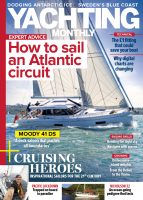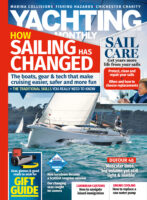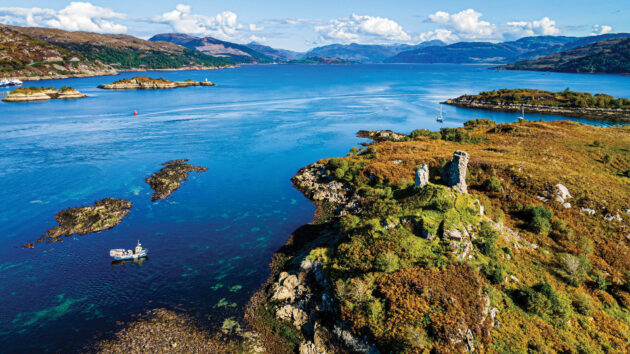Nick Leather sails his Westerly Storm, Musketeer, from the Inner Hebrides to the South Coast – the final stages of a tremendous circumnavigation of the British Isles
Sea spray rose over the pushpit and the bow plunged into the restless black sea topped by frothing white streaks. The gusts came thick and fast while the wind moaned forlornly in the rigging. We were aboard Musketeer, valiantly battling rough seas off the northeast coast of Norfolk on the final stages of our circumnavigation.
Our adventure had started a couple of months earlier when we had set off from Kerrera marina, on the Scottish west coast, for the final stretch of our clockwise circumnavigation of Britain. Our destination, with many crew changes, was our home base Portland on the South Coast.
We had started our circumnavigation from Portland a year earlier and had wintered in Conwy, north Wales, before arriving in Kerrera.
The final leg began in the morning drizzle, with Keith, my 84-year-old father-in-law, my son Ben and I heading out from Kerrera, opposite Oban, sailing north towards the Sound of Mull.
As the wind lightened, we shook out the reef as we passed the island of Lismore, sailing up the Sound of Mull past the majestic Duart Castle. The green hillsides were dotted with sheep and we noted many waterfalls through the mist. We made good progress, clocking up to seven knots over ground.
Hours later, we tacked past the grey lighthouse at the remote and wild Ardnamurchan Point, the most westerly point on the British mainland, and up the Sound of Sleet. We could see the hazy outline of the small islands of Muck and Eigg, with the Atlantic Ocean beyond.
With a Force 8 storm forecast, we decided to anchor in the scenic bay of Ornsay on the southeast coast of the island of Skye. It was an unscheduled 24-hour stay but with such a dramatic landscape it was not too much of a hardship.

Photo: Nick Leather
In the shadow of giants
The wind finally settled and in a cool gloomy light we departed the next morning as scudding dark clouds started to break up and the sun illuminated the upper cumuli. Dwarfed by the mountainous landscape we edged into the narrow stretch of the tidal gated Kyle Rhea as seals gazed away curiously.
A brief stop at Loch Alsh allowed us to restock our supplies before we pressed on passing beneath the impressive 29m-high bridge to the Isle of Skye.
As we left the Crowlin Islands to starboard, small random storm cells crossed the skies and we were hit by several squalls, getting rather wet.
We sailed a further 35 miles north, passing many remote lochs and eventually anchored in the lee of Ewe island. Sleepy seals eyeballed us from the beach as Musketeer swung on her mooring in front of the tussocks of grass.

Alongside at Scrabster, where the smell of pine wood mingled with that of fish and chips. Photo: Nick Leather
A fierce Force 6 hit us on the nose the next morning with endless stiff oncoming waves amid the mist and drizzle. After a long slog, we finally negotiated the rocky inshore passage of Loch Inchard to shelter in the small fishing port at Kinlochbervie. We tied up among the fishing trawlers overnight.
Listening to weather forecasts from Cape Wrath to Rattray Head over the years had conjured up visions of gales with exploding waves pummelling the cliffs. Fortunately, our fears were unfounded.
The beast was tamed as we left the small islet of Am Balg to starboard and in very light winds motor-sailed around this notorious headland. What a relief!
Heading east
The Sutherland coast line slipped by with towering mountains framing the landscape. We passed Loch Erboli and with the light fading, we made for our anchorage in the shallow loch of the Kyle of Tongue.

Tim at the helm as Musketeer makes her way down the Solent
In 1746, history records a Naval engagement involving Bonnie Prince Charlie. We anchored between two islets of Rabbit Island with the setting sun shimmering gold on the water’s surface.
As we sailed on, vague black dots on the horizon appeared. We could now see the Orkney islands in the distance and the car ferries oscillating backwards and forwards to the mainland. We tacked into Scrabster and made our way to the inner harbour to be greeted by a strong smell of fish.
Article continues below…
Zhik Spirit of Adventure: ‘It’s a little bit of heaven – two miles of sand backed by dunes held together by ancient and gnarled juniper trees’
Good luck going round the Peloponnese,’ smiled the seasoned sailor as I told him our plans. He stood at the…
Zhik Spirit of Adventure: ‘Wonderful opportunities for whale watching as these gracious creatures head north’
Sailing a yacht down to Antarctica can be an incredible adventure. Get it right and it will earn its ‘voyage…
Up early with the sun rising over Dunnet Head, we sailed out into the Pentland Firth the next day. The Firth is renowned for its dangerously strong tides, among the fastest in the world, with speeds in excess of 10 knots, and the associated tide races and overfalls.
Today, however, the sea was quite settled. We passed the Island of Stroma with derelict cottages sprinkled on the green landscape and sailed round Dunnet Head. We then tacked up the sickle-shaped Sinclair Bay lined with golden sand and entered Wick. A compulsory stop at the Old Pulteney distillery was necessary to sample its fine single malts.
Crossing the moray firth
The picturesque town of Lossiemouth was the next destination. We passed imposing oil rig structures en route across the wide Moray Firth and we arrived in the early hours. Musketeer would stay in Lossiemouth for one month to have work done. It was rather strange to see her on a webcam from 400 miles away in Somerset.
For the next hop, Todor would be my only crew helping navigate from Lossiemouth to Newcastle.

Ben and Keith happy to have negotiated Cape Wrath safely. Photo: Nick Leather
We departed Lossiemouth in a northwesterly Force 5, enjoying a fine reach to Peterhead in a moderate slight sea before the weather became more challenging. The winds strengthened as we departed into a rolling sea and with slow progress we sought another bolt hole.
Our passage to Arbroath was a tedious beat up to Aberdeen with an unpleasant sea state and gusting winds. We decided to bail out, starting to feel a little green, and tucked ourselves in behind the sheltered high walls of the sandstone harbour at Stonehaven.
The next morning we set sail past Dunnottar Castle, situated on the top of a sheer, 160ft cliff. The old ruin oozed with many historical events. William Wallace attacked the castle in 1297 showing little mercy to the English.
Hopefully he would be more obliging today and with no arrow volleys flying over the castellated walls it seemed safe to continue our passage and we later pressed on to Eyemouth arriving in the dark.

The route
Another crew change
The next day, we motor-sailed in light winds and a drizzle past Holy Island to starboard and negotiated the Inner Sound as the hazy Farne Islands spread around to port. The impressive Bamburgh castle stood with a commanding view of the bay with the nearby Black Rock white sector light winking away.
The sobering effects of avian flu were apparent as a pair of dead puffins floated limply on the surface. Later we approached the River Tyne as the visibility dropped considerably with a veil of low cloud obscuring the break water but with help of GPS we found the entrance and sallied up the river and berthed at Royal Quays marina.
Another change of crew welcoming Keith and nephew Eddie back aboard. With heading winds we sallied out of the Tyne for Whitby. In the twilight, we could see the twinkling lights of Sunderland, Hartlepool and Middlesbrough while the penetrating beam of Whitby light house beckoned us on.

Aerial of Dunnottar Castle, near Stonehaven. Photo: Nick Leather
At 0300, we finally slipped into Whitby harbour and we made our way along the wooden pier extension up the Esk estuary. With the eery outline of Whitby Abbey on the skyline it brought thoughts of Bram Stoker’s Dracula – fortunately no malign bat or cloaked fanged crone appeared on board.
Another night crossing would take us past Flamborough Head, two large wind farms and across the busy Humber with banks of mist drifting across the bustling shipping lanes. We put into the historic port of Grimsby with its original wooden fishing jetties and buildings.
We were now on the final push, with Tim rejoining as a replacement crew. As we sailed around East Anglia we saw the landscape change from the mountainous terrain of Scotland to the soft undulating landscapes of Suffolk and Norfolk. We saw the shingle spit at Orford Ness and the villages Aldeburgh and Cromer. We stopped in Wells, Lowestoft and Harwich to take some well earned rest.
At Half Penny Pier near Trinity light house, our arrival was rewarded by a beautiful burning sunset.

Stonehaven was a useful refuge on the east coast of Scotland. Photo: Nick Leather
Tricky navigation
The next day, we crossed the Thames which required navigating between the sand banks, colossal wind farms and dodging the cargo ships ploughing their way down the Queen’s Channel shipping lane. The sea state was smooth with such light winds that we motor-sailed to the shiny new marina at Dover.
As we approached Portland, and home, we sailed past the flat cobbled beaches of Rye, Hythe and Hasting, a marked contrast from the whiter than white undulating cliffs of Beachy Head and the Seven Sisters.
The wind direction was generally frustrating. With the wind on the nose, we now had to beat and motor sail our passage to Eastbourne and then onto Shoreham on Sea. We made our way through the Shoreham breakwater and into the lock, spending the night alongside as small boats travelled up and down the Arne river.
We could almost smell the scent of home as we made for the Looe Channel in a drizzle. We carefully crossed the shipping channels and tacked up the Solent, taking rest in the marina. The next day saw high winds – Force 7-8 – so we were not going anywhere! The day proved to be a useful day for maintenance and rest.

Nick with Musketeer. Photo: Nick Leather
On the home straight
As the wind abated, we sailed back out into the Solent and tacked up the westerly approach.
We stemmed the last of the current to make the Needles Channel tidal gate. Our timing was good as we made 9 knots over the ground on a beam reach into Dolphin Bay and the port channel markers quickly slid by. A few squalls made for some hasty reefing as we sailed on.
After passing the prominent St Albans Head, we made our way across Weymouth Bay and the dramatic backdrop of the Jurassic coast. Before long we were entering the familiar harbour walls of Portland, and we were finally home.
This article is a part of our Zhik Spirit of Adventure Awards.
Enjoyed reading this?
A subscription to Yachting Monthly magazine costs around 40% less than the cover price, so you can save money compared to buying single issues.
Print and digital editions are available through Magazines Direct – where you can also find the latest deals.
YM is packed with information to help you get the most from your time on the water.
-
-
- Take your seamanship to the next level with tips, advice and skills from our experts
- Impartial in-depth reviews of the latest yachts and equipment
- Cruising guides to help you reach those dream destinations
-
Follow us on Facebook, Twitter and Instagram.
Note: We may earn a commission when you buy through links on our site, at no extra cost to you. This doesn’t affect our editorial independence.






